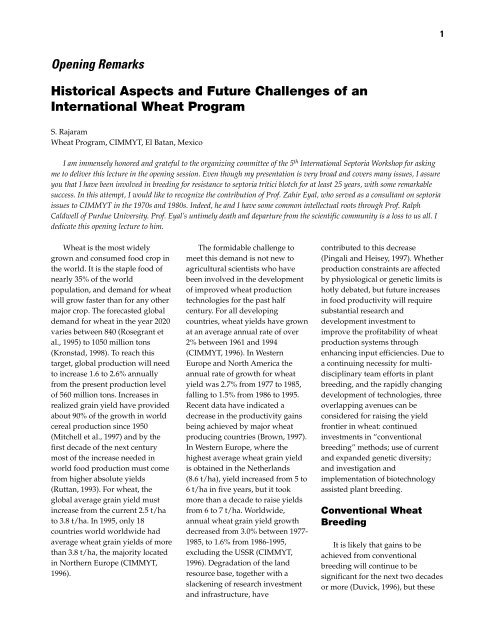Septoria and Stagonospora Diseases of Cereals - CIMMYT ...
Septoria and Stagonospora Diseases of Cereals - CIMMYT ...
Septoria and Stagonospora Diseases of Cereals - CIMMYT ...
Create successful ePaper yourself
Turn your PDF publications into a flip-book with our unique Google optimized e-Paper software.
Opening Remarks<br />
Historical Aspects <strong>and</strong> Future Challenges <strong>of</strong> an<br />
International Wheat Program<br />
S. Rajaram<br />
Wheat Program, <strong>CIMMYT</strong>, El Batan, Mexico<br />
I am immensely honored <strong>and</strong> grateful to the organizing committee <strong>of</strong> the 5 th International <strong>Septoria</strong> Workshop for asking<br />
me to deliver this lecture in the opening session. Even though my presentation is very broad <strong>and</strong> covers many issues, I assure<br />
you that I have been involved in breeding for resistance to septoria tritici blotch for at least 25 years, with some remarkable<br />
success. In this attempt, I would like to recognize the contribution <strong>of</strong> Pr<strong>of</strong>. Zahir Eyal, who served as a consultant on septoria<br />
issues to <strong>CIMMYT</strong> in the 1970s <strong>and</strong> 1980s. Indeed, he <strong>and</strong> I have some common intellectual roots through Pr<strong>of</strong>. Ralph<br />
Caldwell <strong>of</strong> Purdue University. Pr<strong>of</strong>. Eyal’s untimely death <strong>and</strong> departure from the scientific community is a loss to us all. I<br />
dedicate this opening lecture to him.<br />
Wheat is the most widely<br />
grown <strong>and</strong> consumed food crop in<br />
the world. It is the staple food <strong>of</strong><br />
nearly 35% <strong>of</strong> the world<br />
population, <strong>and</strong> dem<strong>and</strong> for wheat<br />
will grow faster than for any other<br />
major crop. The forecasted global<br />
dem<strong>and</strong> for wheat in the year 2020<br />
varies between 840 (Rosegrant et<br />
al., 1995) to 1050 million tons<br />
(Kronstad, 1998). To reach this<br />
target, global production will need<br />
to increase 1.6 to 2.6% annually<br />
from the present production level<br />
<strong>of</strong> 560 million tons. Increases in<br />
realized grain yield have provided<br />
about 90% <strong>of</strong> the growth in world<br />
cereal production since 1950<br />
(Mitchell et al., 1997) <strong>and</strong> by the<br />
first decade <strong>of</strong> the next century<br />
most <strong>of</strong> the increase needed in<br />
world food production must come<br />
from higher absolute yields<br />
(Ruttan, 1993). For wheat, the<br />
global average grain yield must<br />
increase from the current 2.5 t/ha<br />
to 3.8 t/ha. In 1995, only 18<br />
countries world worldwide had<br />
average wheat grain yields <strong>of</strong> more<br />
than 3.8 t/ha, the majority located<br />
in Northern Europe (<strong>CIMMYT</strong>,<br />
1996).<br />
The formidable challenge to<br />
meet this dem<strong>and</strong> is not new to<br />
agricultural scientists who have<br />
been involved in the development<br />
<strong>of</strong> improved wheat production<br />
technologies for the past half<br />
century. For all developing<br />
countries, wheat yields have grown<br />
at an average annual rate <strong>of</strong> over<br />
2% between 1961 <strong>and</strong> 1994<br />
(<strong>CIMMYT</strong>, 1996). In Western<br />
Europe <strong>and</strong> North America the<br />
annual rate <strong>of</strong> growth for wheat<br />
yield was 2.7% from 1977 to 1985,<br />
falling to 1.5% from 1986 to 1995.<br />
Recent data have indicated a<br />
decrease in the productivity gains<br />
being achieved by major wheat<br />
producing countries (Brown, 1997).<br />
In Western Europe, where the<br />
highest average wheat grain yield<br />
is obtained in the Netherl<strong>and</strong>s<br />
(8.6 t/ha), yield increased from 5 to<br />
6 t/ha in five years, but it took<br />
more than a decade to raise yields<br />
from 6 to 7 t/ha. Worldwide,<br />
annual wheat grain yield growth<br />
decreased from 3.0% between 1977-<br />
1985, to 1.6% from 1986-1995,<br />
excluding the USSR (<strong>CIMMYT</strong>,<br />
1996). Degradation <strong>of</strong> the l<strong>and</strong><br />
resource base, together with a<br />
slackening <strong>of</strong> research investment<br />
<strong>and</strong> infrastructure, have<br />
1<br />
contributed to this decrease<br />
(Pingali <strong>and</strong> Heisey, 1997). Whether<br />
production constraints are affected<br />
by physiological or genetic limits is<br />
hotly debated, but future increases<br />
in food productivity will require<br />
substantial research <strong>and</strong><br />
development investment to<br />
improve the pr<strong>of</strong>itability <strong>of</strong> wheat<br />
production systems through<br />
enhancing input efficiencies. Due to<br />
a continuing necessity for multidisciplinary<br />
team efforts in plant<br />
breeding, <strong>and</strong> the rapidly changing<br />
development <strong>of</strong> technologies, three<br />
overlapping avenues can be<br />
considered for raising the yield<br />
frontier in wheat: continued<br />
investments in “conventional<br />
breeding” methods; use <strong>of</strong> current<br />
<strong>and</strong> exp<strong>and</strong>ed genetic diversity;<br />
<strong>and</strong> investigation <strong>and</strong><br />
implementation <strong>of</strong> biotechnology<br />
assisted plant breeding.<br />
Conventional Wheat<br />
Breeding<br />
It is likely that gains to be<br />
achieved from conventional<br />
breeding will continue to be<br />
significant for the next two decades<br />
or more (Duvick, 1996), but these









